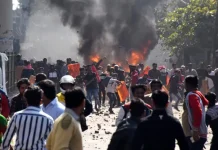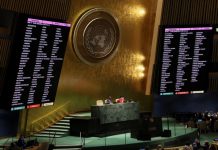
Jewish prayers at Jerusalem’s most sensitive holy site, known to Jews as the Temple Mount and to Muslims as the Noble Sanctuary, were once unthinkable.
But now, with police protection, it has become the recent norm for Jews to pray at the shrine under the shadow of Jerusalem’s golden Dome of the Rock.
The new convention strains a delicate status quo and raises fears of triggering a new wave of violence in the Middle East.
“What is happening is a blatant and dangerous violation of the status quo,” said Sheikh Omar Al-Kiswani, a top official with the Waqf, the Jordanian-backed Islamic trust that administers the site. “The Israeli police must stop providing protection to extremists.”
The hilltop compound is the holiest site for Jews, revered as the location of two ancient temples destroyed in antiquity. Three times a day for 2,000 years, Jews have turned to face it during prayers. It also is home to the Al-Aqsa Mosque, the third-holiest site in Islam.
Israel captured the hilltop, along with the rest of east Jerusalem and the walled Old City, in the 1967 Mideast war and later annexed it, a move that was not recognized by most of the international community.
Since 1967, a loose set of rules known as the “status quo” have governed day-to-day operations at the site. Any actual or perceived changes to the status quo has the potential to ignite violence.
For decades, Jews avoided worship at the site for religious reasons. Many leading rabbis, including the country’s Chief Rabbinate, ruled after the 1967 war that Jews “should not enter the entire area of the Temple Mount.”
New Prime Minister Naftali Bennett, who leads a small, hard-line religious party, caused an uproar last month on the Jewish fast day of Tisha B’Av when he said Israel was committed to protecting “freedom of worship” for Jews at the compound.









